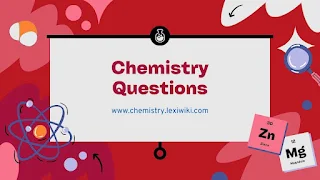Questions on Amorphous Solids
20 Multiple-Choice Questions on Amorphous Solids
1. What distinguishes an amorphous solid from a crystalline solid?
A) It has a definite melting point.
B) Its atoms or molecules are arranged in a random, disordered way.
C) It has a highly ordered atomic structure.
D) It always conducts electricity.
E) It has a fixed geometric shape.
2. Which of the following is an example of an amorphous solid?
A) Sodium chloride (NaCl)
B) Diamond
C) Glass
D) Quartz
E) Ice
3. Amorphous solids typically:
A) Have sharp melting points
B) Have indefinite melting points
C) Conduct electricity well
D) Are highly brittle
E) Have a crystalline lattice
4. Which property is common in amorphous solids?
A) Long-range order
B) Isotropic physical properties
C) Fixed melting point
D) Regular atomic arrangement
E) High electrical conductivity
5. The lack of long-range order in amorphous solids results in:
A) Anisotropic properties
B) Isotropic properties
C) High brittleness
D) High melting point
E) Ionic bonding
6. Which process is commonly used to produce glass, an amorphous solid?
A) Slow cooling of a melt
B) Rapid cooling (quenching) of a melt
C) Sublimation
D) Crystallization
E) Electroplating
7. How do amorphous solids behave upon heating?
A) They melt sharply at a specific temperature.
B) They soften over a temperature range.
C) They vaporize immediately.
D) They remain solid indefinitely.
E) They decompose chemically.
8. Which of these materials is NOT typically considered an amorphous solid?
A) Rubber
B) Glass
C) Plastic
D) Salt crystal
E) Wax
9. Which statement about the structure of amorphous solids is true?
A) Atoms are arranged in a repeating pattern.
B) Atoms are arranged randomly without periodicity.
C) They have ionic lattices.
D) They have metallic bonding.
E) They are always soft and flexible.
10. Which of the following is an example of a polymer that can form an amorphous solid?
A) Polyethylene
B) Sodium chloride
C) Diamond
D) Quartz
E) Ice
11. What property do amorphous solids share with liquids?
A) They flow easily at room temperature.
B) They have no fixed volume.
C) They lack long-range order.
D) They conduct electricity.
E) They have a sharp melting point.
12. Which of the following is a practical use of amorphous solids?
A) Semiconductor chips
B) Optical lenses (glass)
C) Table salt seasoning
D) Steel beams
E) Diamond cutting tools
13. Which type of bonding is generally present in amorphous solids like glass?
A) Ionic
B) Covalent
C) Metallic
D) Van der Waals forces
E) Hydrogen bonding
14. Which of the following is NOT a characteristic of amorphous solids?
A) They have definite shape and volume
B) They have a fixed and sharp melting point
C) They have isotropic properties
D) Their atoms do not have long-range order
E) They can be brittle or flexible
15. Why are amorphous solids sometimes called “supercooled liquids”?
A) Because they have a crystalline structure
B) Because they behave like liquids trapped in a solid form
C) Because they flow easily at room temperature
D) Because they are always transparent
E) Because they conduct electricity
16. Which of the following solids is an example of an amorphous solid formed by rapid cooling?
A) Granite
B) Quartz
C) Glass
D) Salt
E) Ice
17. Compared to crystalline solids, amorphous solids usually:
A) Have higher melting points
B) Have more uniform mechanical properties in all directions
C) Are more brittle
D) Have a regular lattice structure
E) Are always metallic
18. Which physical property can best help distinguish between an amorphous and a crystalline solid?
A) Electrical conductivity
B) Color
C) Melting behavior
D) Hardness
E) Density
19. Which of these is a disadvantage of amorphous solids compared to crystalline solids?
A) Lack of defined melting point complicates processing
B) They are too hard to shape
C) They conduct electricity too well
D) They always have toxic elements
E) They have a rigid lattice
20. Which type of solid structure allows for cleavage along specific planes?
A) Amorphous solids
B) Crystalline solids
C) Both amorphous and crystalline solids
D) Only metals
E) Gases
Answer Key
1. B
2. C
3. B
4. B
5. B
6. B
7. B
8. D
9. B
10. A
11. C
12. B
13. B
14. B
15. B
16. C
17. B
18. C
19. A
20. B
Dive into the groundbreaking science of neurotransmitters—your brain’s invisible architects—in Chemical Harmony: How Neurotransmitters Shape Our Lives (2025). This meticulously researched book reveals how serotonin, dopamine, GABA, and other brain chemicals silently orchestrate every aspect of your existence, from decision-making and relationships to mental health and emotional resilience.Click here to buy
Share Online!

